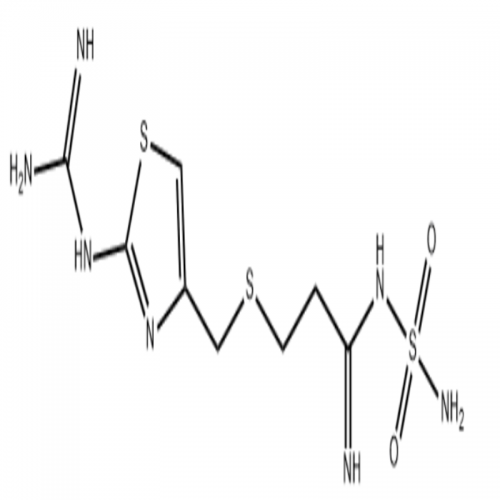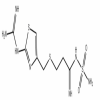

Bromfenac sodium,Acotiamide,BI6727,Plinabulin
| CAS No.: | 76824-35-6 |
| Content: | 98% |
| Packaging: | custom |
| Price valid (until): | 2023-04-07 |
Product Detail
| Product name | (1Z)-3-[({2-[(DIAMINOMETHYLIDENE)AMINO]-1,3-THIAZOL-4-YL}METHYL)SULFANYL]-N'-SULFAMOYLPROPANIMIDAMIDE |
|---|
| Product number | - |
|---|---|
| Other names | Famotidine; pepcid; pepdul |
| Identified uses | Industrial and scientific research use. |
|---|---|
| Uses advised against | no data available |
| Company | Maydy Biotechnology Co., Ltd. |
|---|---|
| Address | No.118, No.119, No.120, Area A, Headquarters Economic Industrial Park, Higher Vocational Park, No. 12 Chengxin Road, Gaochun District, Nanjing, Jiangsu Province, China |
| Mobile | 86-18251822644 |
| Emergency phone number | 86-19941775929 |
|---|---|
| Service hours | Monday to Friday, 9am-5pm (Standard time zone: UTC/GMT +8 hours). |
Skin irritation, Category 2
Eye irritation, Category 2
| Pictogram(s) |  |
|---|---|
| Signal word | Warning |
| Hazard statement(s) | H315 Causes skin irritation H319 Causes serious eye irritation |
| Precautionary statement(s) | |
| Prevention | P264 Wash ... thoroughly after handling. P280 Wear protective gloves/protective clothing/eye protection/face protection/hearing protection/... |
| Response | P302+P352 IF ON SKIN: Wash with plenty of water/... P321 Specific treatment (see ... on this label). P332+P317 If skin irritation occurs: Get medical help. P362+P364 Take off contaminated clothing and wash it before reuse. P305+P351+P338 IF IN EYES: Rinse cautiously with water for several minutes. Remove contact lenses, if present and easy to do. Continue rinsing. |
| Storage | none |
| Disposal | none |
no data available
| Chemical name | Common names and synonyms | CAS number | EC number | Concentration |
|---|---|---|---|---|
| (1Z)-3-[({2-[(DIAMINOMETHYLIDENE)AMINO]-1,3-THIAZOL-4-YL}METHYL)SULFANYL]-N'-SULFAMOYLPROPANIMIDAMIDE | (1Z)-3-[({2-[(DIAMINOMETHYLIDENE)AMINO]-1,3-THIAZOL-4-YL}METHYL)SULFANYL]-N'-SULFAMOYLPROPANIMIDAMIDE | 76824-35-6 | 616-396-9 | 100% |
Move the victim into fresh air. If breathing is difficult, give oxygen. If not breathing, give artificial respiration and consult a doctor immediately. Do not use mouth to mouth resuscitation if the victim ingested or inhaled the chemical.
Take off contaminated clothing immediately. Wash off with soap and plenty of water. Consult a doctor.
Rinse with pure water for at least 15 minutes. Consult a doctor.
Rinse mouth with water. Do not induce vomiting. Never give anything by mouth to an unconscious person. Call a doctor or Poison Control Center immediately.
no data available
no data available
Use dry chemical, carbon dioxide or alcohol-resistant foam.
no data available
Wear self-contained breathing apparatus for firefighting if necessary.
Avoid dust formation. Avoid breathing mist, gas or vapours.Avoid contacting with skin and eye. Use personal protective equipment.Wear chemical impermeable gloves. Ensure adequate ventilation.Remove all sources of ignition. Evacuate personnel to safe areas.Keep people away from and upwind of spill/leak.
Prevent further spillage or leakage if it is safe to do so. Do not let the chemical enter drains. Discharge into the environment must be avoided.
Collect and arrange disposal. Keep the chemical in suitable and closed containers for disposal. Remove all sources of ignition. Use spark-proof tools and explosion-proof equipment. Adhered or collected material should be promptly disposed of, in accordance with appropriate laws and regulations.
Handling in a well ventilated place. Wear suitable protective clothing. Avoid contact with skin and eyes. Avoid formation of dust and aerosols. Use non-sparking tools. Prevent fire caused by electrostatic discharge steam.
Store the container tightly closed in a dry, cool and well-ventilated place. Store apart from foodstuff containers or incompatible materials.
no data available
no data available
Ensure adequate ventilation. Handle in accordance with good industrial hygiene and safety practice. Set up emergency exits and the risk-elimination area.
Wear tightly fitting safety goggles with side-shields conforming to EN 166(EU) or NIOSH (US).
Wear fire/flame resistant and impervious clothing. Handle with gloves. Gloves must be inspected prior to use. Wash and dry hands. The selected protective gloves have to satisfy the specifications of EU Directive 89/686/EEC and the standard EN 374 derived from it.
If the exposure limits are exceeded, irritation or other symptoms are experienced, use a full-face respirator.
no data available
| Physical state | White to off-white crystalline powder |
|---|---|
| Colour | no data available |
| Odour | no data available |
| Melting point/freezing point | 100°C(dec.)(lit.) |
| Boiling point or initial boiling point and boiling range | 130°C/13mmHg(lit.) |
| Flammability | no data available |
| Lower and upper explosion limit/flammability limit | no data available |
| Flash point | 23°C(lit.) |
| Auto-ignition temperature | no data available |
| Decomposition temperature | no data available |
| pH | no data available |
| Kinematic viscosity | no data available |
| Solubility | In water: 1.1 mg/mL |
| Partition coefficient n-octanol/water | no data available |
| Vapour pressure | no data available |
| Density and/or relative density | 1.83 g/cm3 |
| Relative vapour density | no data available |
| Particle characteristics | no data available |
no data available
no data available
no data available
no data available
no data available
no data available
no data available
no data available
no data available
no data available
no data available
no data available
no data available
no data available
no data available
no data available
no data available
no data available
no data available
The material can be disposed of by removal to a licensed chemical destruction plant or by controlled incineration with flue gas scrubbing. Do not contaminate water, foodstuffs, feed or seed by storage or disposal. Do not discharge to sewer systems.
Containers can be triply rinsed (or equivalent) and offered for recycling or reconditioning. Alternatively, the packaging can be punctured to make it unusable for other purposes and then be disposed of in a sanitary landfill. Controlled incineration with flue gas scrubbing is possible for combustible packaging materials.
| ADR/RID: UN1920 (For reference only, please check.) | IMDG: UN1920 (For reference only, please check.) | IATA: UN1920 (For reference only, please check.) |
| ADR/RID: NONANES (For reference only, please check.) | IMDG: NONANES (For reference only, please check.) | IATA: NONANES (For reference only, please check.) |
| ADR/RID: 3 (For reference only, please check.) | IMDG: 3 (For reference only, please check.) | IATA: 3 (For reference only, please check.) |
| ADR/RID: III (For reference only, please check.) | IMDG: III (For reference only, please check.) | IATA: III (For reference only, please check.) |
| ADR/RID: No | IMDG: No | IATA: No |
no data available
no data available
| Chemical name | Common names and synonyms | CAS number | EC number |
|---|---|---|---|
| (1Z)-3-[({2-[(DIAMINOMETHYLIDENE)AMINO]-1,3-THIAZOL-4-YL}METHYL)SULFANYL]-N'-SULFAMOYLPROPANIMIDAMIDE | (1Z)-3-[({2-[(DIAMINOMETHYLIDENE)AMINO]-1,3-THIAZOL-4-YL}METHYL)SULFANYL]-N'-SULFAMOYLPROPANIMIDAMIDE | 76824-35-6 | 616-396-9 |
| European Inventory of Existing Commercial Chemical Substances (EINECS) | Not Listed. | ||
| EC Inventory | Not Listed. | ||
| United States Toxic Substances Control Act (TSCA) Inventory | Not Listed. | ||
| China Catalog of Hazardous chemicals 2015 | Not Listed. | ||
| New Zealand Inventory of Chemicals (NZIoC) | Listed. | ||
| Philippines Inventory of Chemicals and Chemical Substances (PICCS) | Not Listed. | ||
| Vietnam National Chemical Inventory | Listed. | ||
| Chinese Chemical Inventory of Existing Chemical Substances (China IECSC) | Not Listed. | ||
| Korea Existing Chemicals List (KECL) | Listed. | ||
| Creation Date | July 15, 2019 |
|---|---|
| Revision Date | July 15, 2019 |
| Items | Specifications |
|---|---|
| Appearance | White or of- white powder or crystlline power,odorless |
| Solubility | Very soluble in N,N-Dimethylformamide,Soluble in methanol,Sparingly soluble inglacial acetic acid, Very slightly soluble inchloroform, Practically insoluble in water. |
| Melting Point | 152°C~156°C |
Office No# 383, 16192 Coastal Highway, Lewes, Delaware 19958, USA